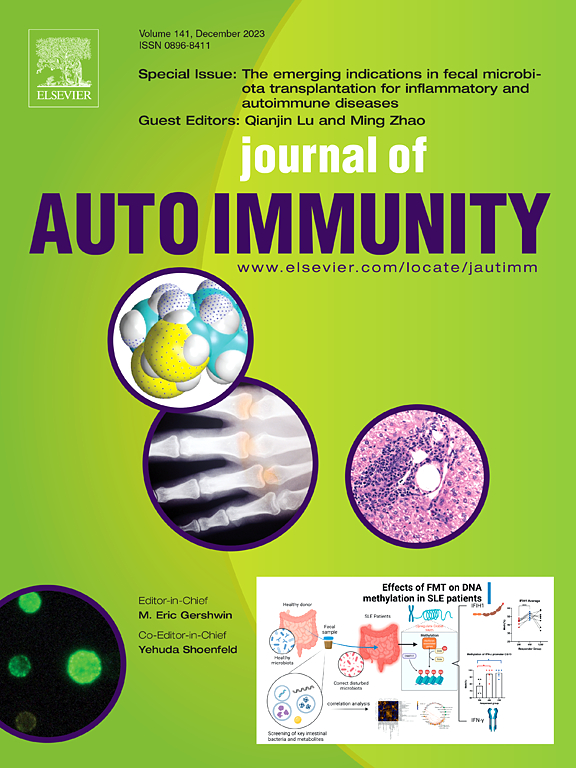预测晚期乳腺癌患者免疫检查点抑制剂毒性的全身免疫特性
IF 7
1区 医学
Q1 IMMUNOLOGY
引用次数: 0
摘要
免疫检查点抑制剂(ICIs)是最有希望的癌症治疗方案之一。然而,与ICI治疗相关的频繁且有时危及生命的免疫相关不良事件(irAEs)。因此,建立irAEs的风险预测模型,识别高危人群,更准确地进行ICI治疗的临床风险-收益分析,降低irAEs的发生率势在必行。然而,目前尚无理想的irae预测模型应用于临床实践。本研究的目的是分析irAEs患者的全身免疫特征,建立预测irAEs风险的模型。方法对接受免疫治疗的晚期乳腺癌患者在治疗过程中和治疗后的irae进行监测。治疗前后采集外周血单个核细胞(PBMCs)。采用细胞计数飞行时间(CyTOF)鉴定基线和治疗后免疫细胞亚群,并探讨这些亚群中细胞比例与irae发生之间的关系。此外,我们根据irae的解剖位置和发病时间进行了亚组分析。此外,我们建立了一个逻辑回归模型来预测irae的风险,并使用来自基因表达综合数据库(GEO)的两个独立验证队列(登录号为GSE189125和GSE186143)对该模型进行了验证。结果通过分析106份血液样本和来自两个独立验证队列(n = 16和60例患者)的样本,我们发现在基线时CXCR3+CCR6+CD4+ T细胞和CD38+CD86+CXCR3+CCR6+CD8+ T细胞的高比例和CXCR3lowCD56dim自然杀伤(NK)细胞的低比例与irAEs的发生率显著相关(P = 0.0029, P <;0.001, P = 0.0017)。在亚组分析中,我们观察到免疫相关性肺炎(ir-pneumonitis)和免疫相关性甲状腺炎(ir-thyroiditis)患者的结果一致。在irAE早期组,CXCR3+CCR6+CD4+ T细胞的基线比例大于irAE晚期组(P = 0.011)。通过对ICI治疗前后PBMCs的分析发现,naïve CD4+ T细胞和CXCR3lowCD56dim NK细胞比例的动态变化与irAE的发生密切相关。最后,我们最终建立了一个预测irae风险的模型,训练队列的受试者工作特征曲线下面积(AUROC)为0.79,单细胞验证队列(GSE189125)的AUROC为0.75。结论这些发现表明,不同的免疫细胞群体与不同的irae相关,这些细胞的特征可能用作预测特定毒性风险的生物标志物。这将有助管理辐照事件,并可能减少辐照事件的发生。本文章由计算机程序翻译,如有差异,请以英文原文为准。
Systemic immune characteristics predicting toxicity to immune checkpoint inhibitors in patients with advanced breast cancer
Background
Immune checkpoint inhibitors (ICIs) are among the most promising treatment options for cancer. However, frequent and sometimes life-threatening immune-related adverse events (irAEs) are associated with ICI treatment. Therefore, it is imperative to establish a model for predicting the risk of irAEs to identify high-risk groups, enable more accurate clinical risk‒benefit analysis for ICI treatment and decrease the incidence of irAEs. However, no ideal model for predicting irAEs has been applied in clinical practice. The aim of this study was to analyze the systemic immune characteristics of patients with irAEs and establish a model for predicting the risk of irAEs.
Methods
We conducted a study to monitor irAEs in patients with advanced breast cancer undergoing immunotherapy during and following the treatment course. Peripheral blood mononuclear cells (PBMCs) were collected before and after two cycles of therapy. Mass cytometry time-of-flight (CyTOF) was employed to identify baseline and posttreatment immune cell subpopulations, and the relationships between the proportions of cells in these subpopulations and the occurrence of irAEs were explored. Additionally, we conducted subgroup analyses stratified by the anatomic location and time of onset of irAEs. Furthermore, we developed a logistic regression model to predict the risk of irAEs and validated this model using two independent validation cohorts from the Gene Expression Omnibus (GEO) database (accession numbers GSE189125 and GSE186143).
Results
By analyzing 106 blood samples and samples from two independent validation cohorts (n = 16 and 60 patients), we found that high proportions of CXCR3+CCR6+CD4+ T cells and CD38+CD86+CXCR3+CCR6+CD8+ T cells and a low proportion of CXCR3lowCD56dim natural killer (NK) cells at baseline were significantly correlated with the incidence of irAEs (P = 0.0029, P < 0.001, and P = 0.0017, respectively). In the subgroup analysis, we observed consistent results in patients with immune-related pneumonitis (ir-pneumonitis) and immune-related thyroiditis (ir-thyroiditis). In the early irAE group, the baseline proportion of CXCR3+CCR6+CD4+ T cells was greater than that in the late irAE group (P = 0.011). An analysis of PBMCs before and after ICI treatment revealed thatthe dynamic changes in the proportions of naïve CD4+ T cells and CXCR3lowCD56dim NK cells were closely related to irAE occurrence. Finally, we ultimately developed a model for predicting the risk of irAEs, which yielded an area under the receiver operating characteristic curve (AUROC) of 0.79 in the training cohort and an AUROC of 0.75 in the single-cell validation cohort (GSE189125).
Conclusions
These findings indicate that different populations of immune cells are associated with different irAEs and that characterization of these cells may be used as biomarkers to predict the risk of specific toxicities. This will facilitate the management of irAEs and may lead to a reduction in the incidence of irAEs.
求助全文
通过发布文献求助,成功后即可免费获取论文全文。
去求助
来源期刊

Journal of autoimmunity
医学-免疫学
CiteScore
27.90
自引率
1.60%
发文量
117
审稿时长
17 days
期刊介绍:
The Journal of Autoimmunity serves as the primary publication for research on various facets of autoimmunity. These include topics such as the mechanism of self-recognition, regulation of autoimmune responses, experimental autoimmune diseases, diagnostic tests for autoantibodies, as well as the epidemiology, pathophysiology, and treatment of autoimmune diseases. While the journal covers a wide range of subjects, it emphasizes papers exploring the genetic, molecular biology, and cellular aspects of the field.
The Journal of Translational Autoimmunity, on the other hand, is a subsidiary journal of the Journal of Autoimmunity. It focuses specifically on translating scientific discoveries in autoimmunity into clinical applications and practical solutions. By highlighting research that bridges the gap between basic science and clinical practice, the Journal of Translational Autoimmunity aims to advance the understanding and treatment of autoimmune diseases.
 求助内容:
求助内容: 应助结果提醒方式:
应助结果提醒方式:


